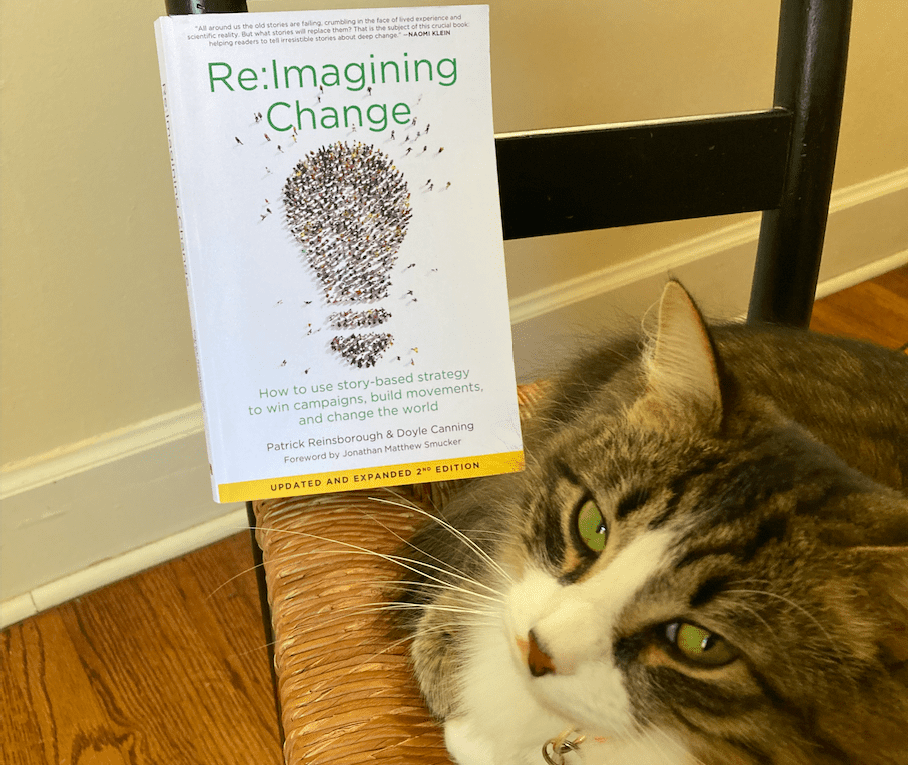I almost didn’t read Re-Imaging Change by Patrick Reinsborough and Doyle Canning. I’ll tell you why, though I’m going to bury the lead here, so stick with me.
I first opened the book and sampled a page. Here’s an example:
“As the story-based strategy approach has evolved, it has generated greater specificity of concept and language. Language structures thought, and story-based strategy is first and foremost a way of thinking, thus, the text includes some specialized terminology.”
Zzzzzz. I focus on climate communications, and simple language is best. The writing above ranks 15 on the Gunning Fog test. This means it’s written on the college level. My formal education is in Chemical Engineering and Physics, so I get it. But as I’ve grown older, my patience for fluffed-up language has grown short, and as a result of reading on line, my attention span has also dwindled. So I braced myself for a slog. I’m glad I did.
We live in a unique period of time, faced by the threats of war, poverty, and particularly, climate collapse. We understand the climate crisis and the science is clear. The consequences of not acting are bleak. So we certainly have reasons to act on climate, but it appears we are failing on a large scale. We think that reason and facts will convince others, that we can scare them into acting. But reason and facts are not enough. Reinsborough and Canning offer another way through creating narratives and stories. They build a case and offer a structure for their sub-title: “How to use story-based strategy to win campaigns, build movements and change the world.”
“Too often progressives think that just because a story is factually true, it will be meaningful to audiences, and therefore build our power. But reality is just the opposite. If a story is meaningful to people, they will believe that it is true. The currency of narrative is not truth, but rather meaning.”
Ok, they’ve won me over. I’m starting to warm to the book, and this writing is clear.
Many in the climate movement know that stories are how we connect, how we share our values, and how we attract others. The book reflects this. But it begins with strategy and narrative analysis, which sound boring. Yet this is often the step I find most organizations miss. I’ve found that communications without strategy is just hot air, and strategy without creative communications and execution is just wishful thinking. Reinsborough and Canning provide a framework for narrative analysis and strategy that clear and easy to follow.
The key here is their process for analyzing the dominant narrative. Too often we try to get our messages heard using the dominant narrative when we need to change the narrative. The example I like to cite is the message, “Renewable energy provides more jobs than the Keystone XL.” This message falls into the trap of the dominant economic jobs narrative of fossil fuels. We will not succeed by trying to “out-jobs” the opposition. Yes jobs are important, but pivoting to a climate justice or a health narrative can make more sense.
While reading their outline of strategy and narrative analysis, I found myself saying, “This makes sense, yes, I’ve forgotten that, so this is a good reminder.”
Next, they discuss the story of the battle as opposed to the battle of the story. Too often we focus on the story of the battle. The media can be prone to this. For example, “One protester was killed in the Stop Cop City protest. 20 were arrested on domestic terrorism charges.” But why is the battle being fought? This is the battle of the story. Is the story that the police force is building a 90 million dollar center to train cops (what), or is it that they are training them to stop freedom of speech and quell dissent (why)? The story of the battle is what is happening, the battle of the story is why it is happening. We need more of the latter. It requires us to understand narratives, as well as select and promote our narrative.
Only after discussing these concepts do the authors launch into the “how-to” of story-telling. They punctuate this by examples of how strategic story-telling has helped movements achieve their goals. Damn, I like it when we win. I’m sold.
Re-Imaging Change should be read by every environmental and climate organizer as well as every grass roots communications leader. Read it. Then take it down from your bookshelf and read it again. Use “… story-based strategy to win campaigns, build movements and change the world.” The book lives up to its promise.
Thanks for what you do.
We are all connected. Savor the Earth!’™
Hobie,
L. Hobart Stocking
SkyWaterEarth.com
hobart@skywaterearth.com
651-357-0110
Facebook: @SkyWaterEarthConnected
Twitter: @SkyWaterEarth








Leave A Comment